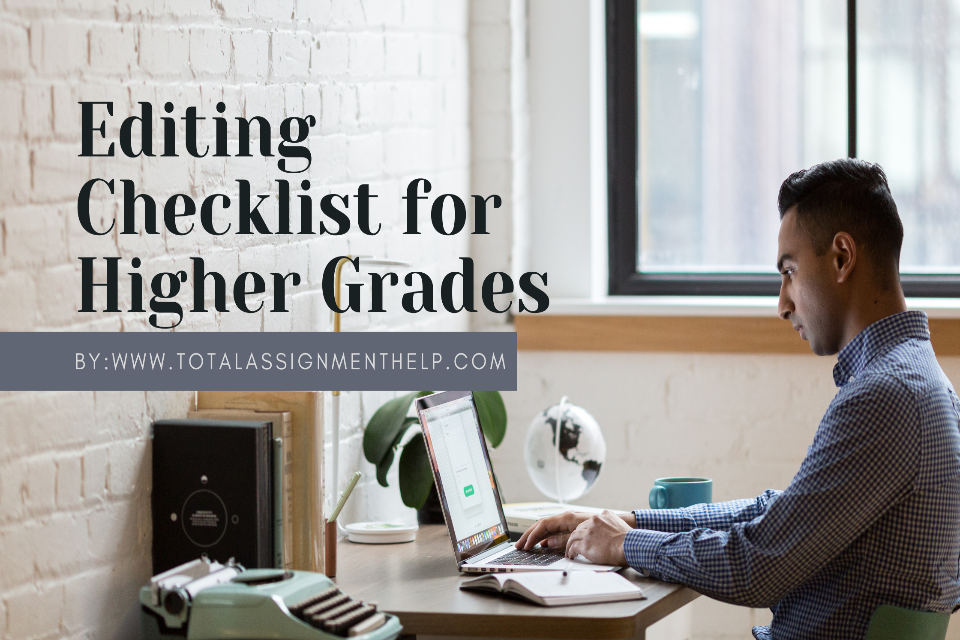Editing Checklist for Higher Grades

The students who are well versed with academic writing will definitely know that creative writing is simply a part of the complete production process of writing the final paper. The success of the paper depends highly on the decision of the student to conduct a few important post-writing activities, which especially includes revising and editing the final paper. It is very common for students who are in the habit of editing and proofreading their papers to get higher grades. For students who are looking to achieve better results, they should consider using an editing checklist. The post-writing stage proves to be quite helpful for students as it allows them to look at their work as a whole rather than a set of disconnected arguments and ideas.
While the revision process aims to improve the writing and gives better clarity of ideas, editing helps to implement proper mechanics. An editing checklist is a set of questions or statements that suggest what the student must focus on, such as proper formatting, spelling, grammar etc.
Proofreading is a great way to remove any errors from the paper so that the readers are not distracted by the author’s central idea. Here is a general editing checklist that will help students no matter their academic level. It is good to follow this checklist to ensure the best of outcomes.
Self and Peer editing checklist:
To ensure you check for a single type of mistake at a time, the following checklist has been divided into several sub-categories allowing for a particularly effective approach and helping students to better concentrate on one aspect at a time.
Capitalisation:
- Ensure that each word of the title of the essay starts with a capital letter.
- Coordinating conjunctions or articles should always begin with a lower case unless they are the first or last words in the title.
- Begin each sentence of the essay with a capital letter.
- Proper nouns like names should start with a capital letter.
- Ensure to have proper capitalisation for all the paper headings aligning to the formatting guidelines.
Spelling:
- Use a spell checker to review and correct any spelling mistakes.
- Take special care when writing some of the commonly mistaken word pairs like there, their, they’re, or too, two and many more.
Punctuation:
- Set off items in a series by properly using commas.
- Make proper use of the Oxford comma, which is also referred to as the Harvard or the serial comma. These are generally placed before conjunctions, which includes three or more items but are not used in the case of two items.
- Ensure to place conjunctions after commas when writing complex sentences.
- Finish every sentence with an appropriate punctuation mark like question marks, exclamation marks, full stops etc.
- Properly use semicolons and colons in the essay.
Grammar:
- In each sentence, it is important to ensure proper agreement between the subjects and the verbs.
- Properly place apostrophes that mark contractions or possessions.
- Avoid sentence run-ons or fragments by having a subject and a verb in each of the sentences.
- All the pronouns used should agree with their antecedents.
- Make use of the active voice when writing the paper and replace any sentences with passive voice with their active voice counterparts.
- Since exclamation marks are not acceptable in academic writing, refrain from using exclamation marks.
- Maintain a proper length for each sentence, and don’t make sentences too long or too short. It is very common to make grammatical errors when writing wrong sentences; therefore, it is wise to replace longer sentences with shorter alternatives.
Format:
- The text should be divided distinctly into separate sections for introduction, body paragraphs and conclusion.
- Use new paragraphs whenever a new idea is introduced to the readers.
- Use new paragraphs whenever there is a change of date or location.
- Fully develop each paragraph by using topic sentences, explanations, pieces of evidence, and concluding sentences in each of the essay’s body paragraphs.
- Properly cite each piece of evidence that you present.
- Quotation marks should be used to present direct quotes.
- Use specific format requirements to present long quotes, such as using a separate block of text, proper punctuation, and in-text citations.
The usual requirements for formatting all academic papers
- Use Times New Roman font with a font size of 12.
- Double-space the text.
- Introduce a 1-inch margin on each side.
- Use a third-person perspective to write the essay.
- Try to avoid non-standard English words when writing the essay.
Students can use this brief editing checklist if they are looking to improve their essays and ensure higher grades. However, if you do not have the time to spare to polish your essays, try using online services.
Frequently Asked Questions
Why is following an editing checklist important?
Following a checklist allows the students to get rid of any errors and revise the text accordingly. It helps them to get better grades.
What are the main aspects to keep in mind when creating an editing checklist?
Grammar, spelling, capitalisation, punctuation and formatting are some of the main aspects to keep in mind when creating an editing checklist.



